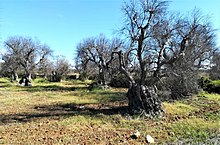Olive quick decline syndrome
The main cause is a strain of the bacterium, Xylella fastidiosa, which is spread by plant-sucking insects such as the meadow froghopper.
The bacteria restrict the flow of sap within the tree and so choke its extremities.
It was first detected in Italy in 2013,[2] in the Salento Peninsula; by late 2013, it was estimated that approximately 8,000 hectares were affected.
[4] In addition to Europe, the disease has also been detected in olive crops in California, Argentina and Brazil.
[6] Symptoms include leaf scorch and desiccation of twigs and branches, beginning at the upper part of the crown and then moving to the rest of the tree, which acquires a burned look.
